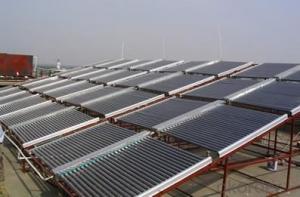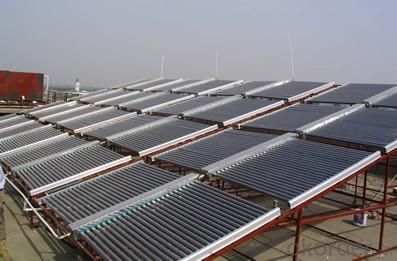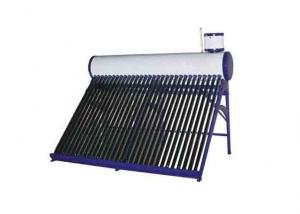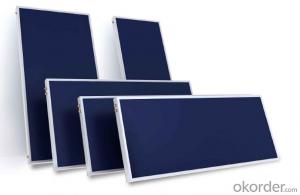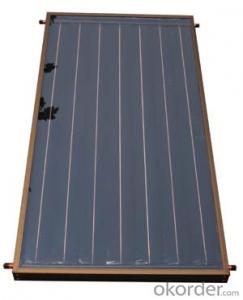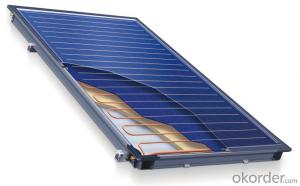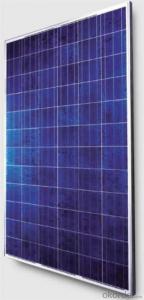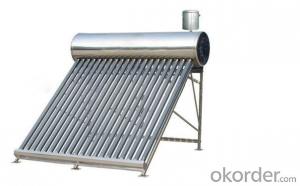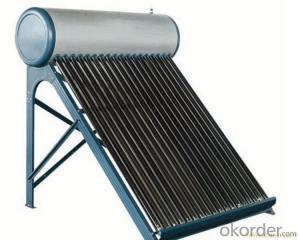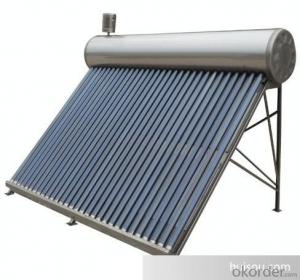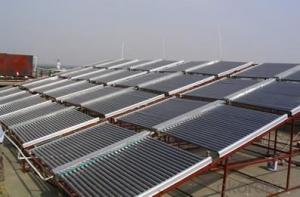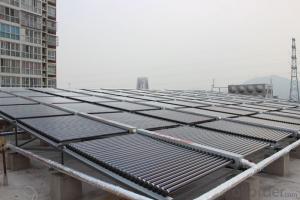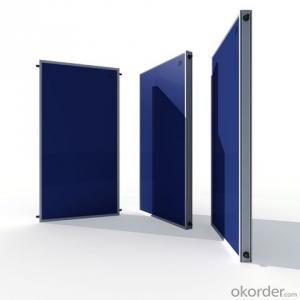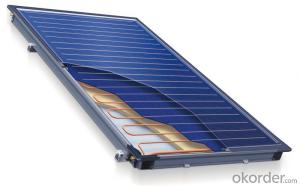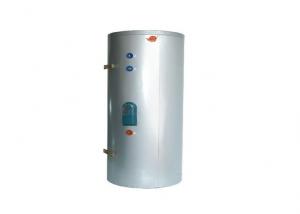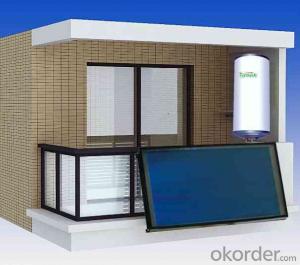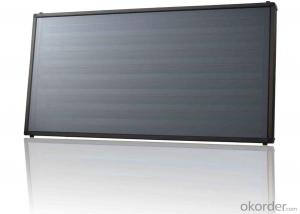Evacuated Tube Solar Collectors Price 2024 New Design Heat Pipe Solar Water Heater System
- Loading Port:
- China main port
- Payment Terms:
- TT OR LC
- Min Order Qty:
- 1 set
- Supply Capability:
- 6000 set/month
OKorder Service Pledge
OKorder Financial Service
You Might Also Like
Introduction of Non-Pressure Solar Water Heater:
Non-pressure Solar Heater is one of the most economical solar water heating device with pretty high efficiency at the same time. It consists of hot water storage tank, solar vacuum tubes with mouth plug in storage tank, and bracket supporting tank and tubes.When cold water in evacuated tubes is heated with solar irradiation, as the specific gravities of hot water and cold water are different, hotter water goes upward to storage tank and colder water goes downward to glass tubes. through this continuous circulation, the cold water in storage tank will be gradually heated till sunset.
Specialty:
1. High thermal performance and working temperature: the heat exchanging rate even in winter can up above 55%.
2. Heat collecting efficiency is at least 20% above common solar systems.
3. Work in all day and all season: no matter any corner of the world, this system can work well even -40℃ to avoid the tube freezing problem.
4. Reliability: No water following through the tube, so water scale can not generate and tube cracks could be avoided, the system still can keep working even with some damaged tubes.
5. It can connect with water tap and work automatically with pressure0.6Mpa, bring enjoyable washing experience.
6. Safety: P/T valve would release pressure and temperature to protect tank..
Technical Specification:
1. Outer tank material: SUS304 stainless steel or powder coated color steel
2. Inner tank material: 1.2mm thick SUS304 food grade stainless steel ( Optional material SUS316L)
3. Vacuum tube material: borosilicate glass 3.3; AL-SS-CU absorb coating, with copper heat pipe inside
4. Frame material: 1.2mm thickness stainless steel
5. Insulation material: 55mm thickness polyurethane
6. Suitable for mains pressure water(up to 8 bar/116psi)
7. Easy plug-in installation
8. Install the T/P valve on the pressurized tank
9. Seal material: Stabilized High Temperature Silicon
Outer tank material: SUS304 stainless steel or powder coated color steel
Inner tank material: 1.2mm thick SUS304 food grade stainless steel ( Optional material SUS316L)
Vacuum tube material: borosilicate glass 3.3; AL-SS-CU absorb coating, with copper heat pipe inside
Frame material: 1.2mm thickness stainless steel
Insulation material: 55mm thickness polyurethane
Suitable for mains pressure water(up to 8 bar/116psi)
Easy plug-in installation
Install the T/P valve on the pressurized tank
Seal material: Stabilized High Temperature Silicon
19. Vacuum Tube | 20. Size (mm) | 21. Φ47*1500 / Φ58*1800 / Φ70*2100 | |||||
22. Tube (pcs) | 23. 10 / 12 / 15 / 18 / 20 / 22 / 24 / 30 / 36 / 42 | ||||||
24. Material | 25. Borosilicate 3.3 glass, magnetron spluttering selective coating | ||||||
26. Coating | 27. Single-target AL-N/AL or Three-target AL/N-Cu-SS | ||||||
28. Water Tank | 29. Capacity | 30. 80L ~ 500L for hot water storage tank | |||||
31. Inner tank | 32. Food-grade stainless steel SUS304-2B / SUS316 | ||||||
33. Insulation | 34. High-density polyurethane foam with 70~80 hour heat preservation | ||||||
35. Tank shell | 36. Food-grade stainless steel SUS304-2B | ||||||
37. Bracket | 38. Shaped strong aluminum alloy structure adaptable for flat or slope roof | ||||||
39. Accessories | 40. Anti-aging silicon seals, Dustproof seals, Air-vent cap, Stainless screws | ||||||
41. Auxiliary Devices | 42. Assistant tank, Intelligent controller, Electrical heater, Magnesium anodes | ||||||
43. Tilt Angle | 44. 25 ~ 50° | ||||||
45. Water Output | 46. 45 - 95°C | ||||||
47. Hail Resistance | 48. Φ25mm diameter | ||||||
49. Model Number | 50. Solar Vacuum Tube | 51. Tank 52. Liter | 53. System 54. Liter | 55. Container Loading Qty /sets | |||
56. Size /mm | 57. Qty /pcs | 58. 20GP | 59. 40GP | 60. 40HQ | |||
61. VNS-58SA12-100 | 62. Φ58*1800 | 63. 12 | 64. 100 | 65. 132 | 66. 58 | 67. 119 | 68. 140 |
69. VNS-58SA15-130 | 70. 15 | 71. 130 | 72. 170 | 73. 54 | 74. 108 | 75. 131 | |
76. VNS-58SA18-150 | 77. 18 | 78. 150 | 79. 198 | 80. 43 | 81. 86 | 82. 105 | |
83. VNS-58SA20-170 | 84. 20 | 85. 170 | 86. 223 | 87. 40 | 88. 80 | 89. 97 | |
VNS-58SA24-200 | 24 | 200 | 263 | 35 | 70 | 85 | |
VNS-58SA30-250 | 30 | 250 | 329 | 28 | 56 | 68 | |
VNS-58SA36-300 | 36 | 300 | 395 | 23 | 47 | 57 | |
Product Show
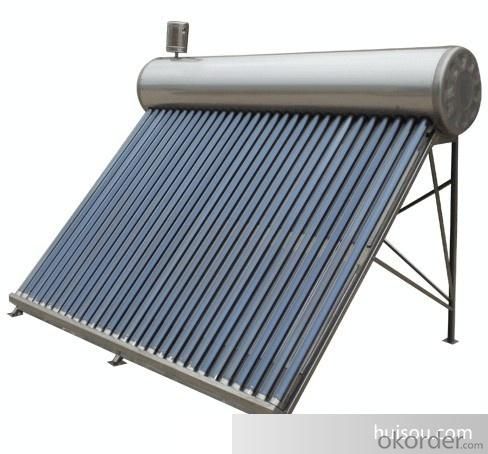
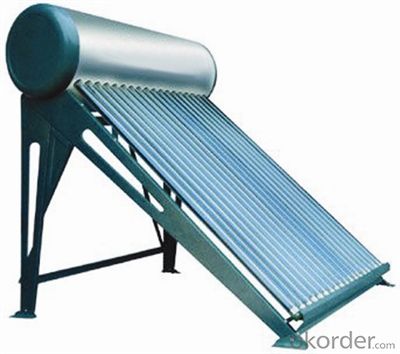
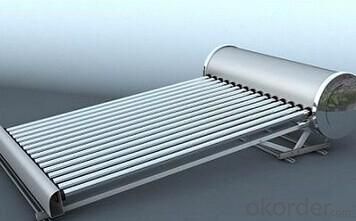
Our Services
1. OEM service
2. Warranty: 5 years
3. Considerable after sale service
Color steel Compact pressure Thermal solar heater
FAQ:
1. What’s the delivery time?
10 days after receiving deposit.
2. How long is the warranty?
5 years for whole system, 1 year for accessory
3. What’s your production capacity?
6000sets/month
4. What’s the MOQ?
1 set.
5. What’s your payment term?
Container: 30% T/T in advance for deposit, 70% T/T before shipment for fist order.
70% T/T after seeing copy of B/L from second order
Sample: 100% T/T in advance
Other choices: L/C at sight.
6. What certifications do you have?
CE, SOLAR KEYMARK, SRCC and etc.
- Q: Can solar collectors be used for heating amusement parks?
- Yes, solar collectors can be used for heating amusement parks. Solar thermal systems can provide a sustainable and cost-effective solution for heating water used in various facilities within amusement parks, such as swimming pools, shower areas, and food service areas. By harnessing the power of the sun, solar collectors can help reduce operational costs and environmental impact, making it an attractive option for heating in amusement parks.
- Q: Can solar collectors be used for heating warehouses and distribution centers?
- Yes, solar collectors can be used for heating warehouses and distribution centers. Solar thermal collectors can capture the sun's energy and convert it into heat, which can then be used to warm up the interior spaces of warehouses and distribution centers. This renewable energy source can help reduce reliance on traditional heating methods and lower energy costs, making it an environmentally friendly and cost-effective solution for heating large commercial spaces.
- Q: Can solar collectors be used for generating electricity on traffic signals?
- Yes, solar collectors can be used for generating electricity on traffic signals. Solar collectors, also known as solar panels or photovoltaic (PV) panels, convert sunlight into electricity using the photovoltaic effect. Traffic signals typically require a continuous supply of electricity, and solar collectors can provide a sustainable and renewable source of power for these systems. Solar collectors can be installed on top of traffic signal poles or nearby structures, where they can capture sunlight and convert it into usable electricity. The electricity generated can then be stored in batteries or fed directly into the grid to power the traffic signals. The excess energy produced during the day can be stored and used during periods of low sunlight or at night. Using solar collectors for generating electricity on traffic signals offers several advantages. Firstly, it reduces the dependence on traditional power sources, such as fossil fuels, which are finite and contribute to pollution and climate change. Solar power is a clean and renewable energy source, reducing carbon emissions and environmental impact. Secondly, solar-powered traffic signals can be more reliable during power outages or grid failures. They can continue to function even when the main power supply is disrupted, ensuring that traffic control is maintained and road safety is not compromised. Moreover, solar collectors require minimal maintenance and have a long lifespan, making them a cost-effective solution in the long run. The initial investment in installing solar panels may be higher, but the savings in electricity bills and the potential for government incentives or grants can offset these costs. In conclusion, solar collectors can indeed be used for generating electricity on traffic signals. They offer a sustainable and renewable energy source, reduce reliance on traditional power sources, ensure continuous operation during power outages, and provide long-term cost savings. Implementing solar-powered traffic signals can contribute to a greener and more energy-efficient transportation infrastructure.
- Q: What is the temperature range of a solar collector?
- The temperature range of a solar collector can vary depending on the type and design, but typically, it can reach temperatures ranging from 70 degrees Fahrenheit (21 degrees Celsius) to 200 degrees Fahrenheit (93 degrees Celsius).
- Q: Can solar collectors be integrated into building designs?
- Yes, solar collectors can be integrated into building designs. They can be installed on rooftops, facades, or integrated into windows, allowing buildings to generate clean, renewable energy while maintaining their aesthetic appeal. This integration not only reduces reliance on traditional energy sources but also maximizes the use of available space for sustainable energy production.
- Q: Can solar collectors be used for swimming pool heating?
- Yes, solar collectors can be used for swimming pool heating. Solar collectors, such as solar panels or solar thermal systems, can absorb sunlight and convert it into heat energy, which can be used to heat swimming pool water. This is a cost-effective and sustainable way to maintain the desired pool temperature without relying on traditional heating methods.
- Q: Can solar collectors be used for heating mines?
- Yes, solar collectors can be used for heating mines. Solar thermal systems can be installed to capture and convert sunlight into heat energy, which can then be used to warm up the mines. This can be a cost-effective and environmentally friendly alternative to traditional heating methods, reducing reliance on fossil fuels and lowering carbon emissions.
- Q: What is the effect of extreme temperatures on solar collectors?
- Extreme temperatures can have both positive and negative effects on solar collectors. On one hand, high temperatures can increase the efficiency of solar collectors by improving the conductivity of heat transfer fluids and increasing the output of electricity. On the other hand, extreme heat can also cause damage to the components of a solar collector, leading to reduced performance and potential system failures. Similarly, extremely low temperatures can reduce the efficiency of solar collectors by decreasing the conductivity of fluids and affecting the performance of photovoltaic cells. It is crucial for solar collectors to be designed and maintained to withstand and mitigate the potential negative effects of extreme temperatures.
- Q: Can solar collectors be used for heating livestock buildings in winter?
- Solar collectors have the potential to heat livestock buildings during winter. They can utilize sunlight to generate heat through solar thermal systems or solar air heaters. This generated heat can then warm the livestock buildings in winter. By placing solar collectors on the buildings' roofs or walls, the captured solar energy can supplement or replace traditional heating methods like fossil fuel-based systems. This sustainable approach reduces greenhouse gas emissions and offers a cost-effective heating solution. Moreover, solar collectors can be combined with thermal storage systems to ensure a continuous supply of heat, even during low sunlight or nighttime. However, it is crucial to consider the specific heating needs of the livestock, the buildings' size and design, and the local climate conditions. These factors determine the optimal sizing and configuration of the solar collectors for efficient heating.
- Q: Can solar collectors be used for heating industrial processes?
- Yes, solar collectors can be used for heating industrial processes. Solar collectors, such as flat plate or evacuated tube collectors, can capture solar energy and convert it into thermal energy. This thermal energy can then be used to heat fluids or air in industrial processes, providing a sustainable and renewable source of heat.
Send your message to us
Evacuated Tube Solar Collectors Price 2024 New Design Heat Pipe Solar Water Heater System
- Loading Port:
- China main port
- Payment Terms:
- TT OR LC
- Min Order Qty:
- 1 set
- Supply Capability:
- 6000 set/month
OKorder Service Pledge
OKorder Financial Service
Similar products
Hot products
Hot Searches
Related keywords
